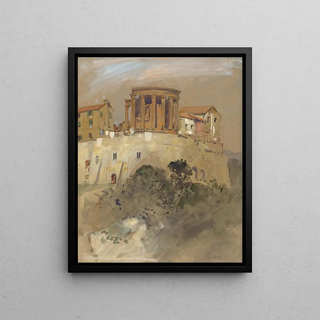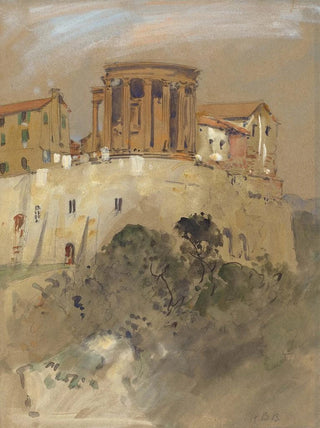Art print | Temple of Vesta at Tivoli - Hercules Brabazon Brabazon


View from behind

Frame (optional)
Art print Temple de Vesta à Tivoli - Hercules Brabazon Brabazon – Engaging Introduction
The "Temple de Vesta à Tivoli" by Hercules Brabazon Brabazon is a work that transports the viewer on a journey through time and space. This painting evokes not only the majesty of Roman architecture but also the serene and mystical atmosphere surrounding this iconic site. By contemplating this piece, one feels a deep connection with the history, culture, and traditions that shaped Antiquity. Brabazon, with his technical mastery and keen sense of light, succeeds in capturing the very essence of this monument, inviting the viewer to linger on the details and subtleties of the scene.
Style and uniqueness of the work
Brabazon's style is distinguished by a blend of romantic and realistic approaches. In "Temple de Vesta à Tivoli," he manages to marry elements of nature with architectural structures, creating a harmonious balance between the built and the natural. The use of light is particularly remarkable, with each ray delicately illuminating the columns and surrounding foliage. The color palette chosen by the artist evokes a soft and soothing atmosphere, where greens and browns blend with rare delicacy. This work does not merely depict a building; it tells a story, that of a place charged with mythology and spirituality, where the remnants of the past continue to resonate in the present.
The artist and his influence
Hercules Brabazon Brabazon, a British painter of the 19th century, is often recognized for his ability to capture the beauty of landscapes and monuments. His work is marked by a fascination with Italy and its architectural wonders, which deeply inspired him throughout his career. As an artist, Brabazon stands at the crossroads between romanticism and realism, influencing a generation of artists to come. His unique approach, combining impressionism and precision, helped redefine the perception of landscape painting in his time. The "Temple de Vesta à Tivoli" is a perfect illustration of this influence, where each brushstroke

Matte finish

View from behind

Frame (optional)
Art print Temple de Vesta à Tivoli - Hercules Brabazon Brabazon – Engaging Introduction
The "Temple de Vesta à Tivoli" by Hercules Brabazon Brabazon is a work that transports the viewer on a journey through time and space. This painting evokes not only the majesty of Roman architecture but also the serene and mystical atmosphere surrounding this iconic site. By contemplating this piece, one feels a deep connection with the history, culture, and traditions that shaped Antiquity. Brabazon, with his technical mastery and keen sense of light, succeeds in capturing the very essence of this monument, inviting the viewer to linger on the details and subtleties of the scene.
Style and uniqueness of the work
Brabazon's style is distinguished by a blend of romantic and realistic approaches. In "Temple de Vesta à Tivoli," he manages to marry elements of nature with architectural structures, creating a harmonious balance between the built and the natural. The use of light is particularly remarkable, with each ray delicately illuminating the columns and surrounding foliage. The color palette chosen by the artist evokes a soft and soothing atmosphere, where greens and browns blend with rare delicacy. This work does not merely depict a building; it tells a story, that of a place charged with mythology and spirituality, where the remnants of the past continue to resonate in the present.
The artist and his influence
Hercules Brabazon Brabazon, a British painter of the 19th century, is often recognized for his ability to capture the beauty of landscapes and monuments. His work is marked by a fascination with Italy and its architectural wonders, which deeply inspired him throughout his career. As an artist, Brabazon stands at the crossroads between romanticism and realism, influencing a generation of artists to come. His unique approach, combining impressionism and precision, helped redefine the perception of landscape painting in his time. The "Temple de Vesta à Tivoli" is a perfect illustration of this influence, where each brushstroke






